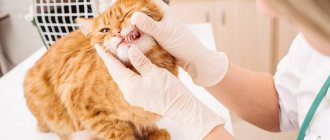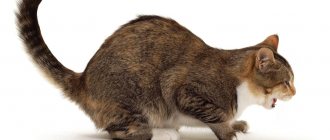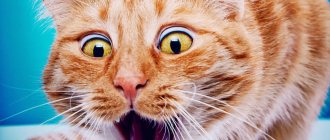12439Administration
1
Cats, like people, get sick often. Coughing and sneezing is not uncommon for them, but a serious symptom! If a cat is sneezing and coughing, this is a sign of illness that the owner needs to be aware of. The mechanism of coughing and sneezing may indicate different reasons for its occurrence - discomfort, colds, illness, allergies, and so on. To quickly help and try to cure a pet is the main task of the owner who cares and loves his pet friend!
A cat is sneezing and coughing - what does this mean?
Sneezing and coughing are a reflex defense of the animal’s body, aimed at eliminating the irritating element. The sneezing response is controlled by the cough center located in the cat's medulla oblongata. Sneezing in a cat is caused by special receptors concentrated on the larynx , trachea, vocal cords and bronchi. The cat sneezes and coughs due to mechanical or chemical irritation of sensitive cough areas. Treatment of a cough symptom is based on the external and internal causes that led to its occurrence. In some cases, you may need the help of a doctor.
To find out the causes of sneezing in cats, you need to pay attention to the following signs and features. This is the time of appearance and end, the strength of manifestation, the duration and timbre of the cough. Of no less importance are the accompanying symptoms, the behavior of the cat, and the nature of the discharge, if any.
© shutterstock
Depending on the signs, veterinarians divide coughing and sneezing in cats into several types:
- Wet and dry, if there is no or no discharge.
- Distressing and debilitating, depending on the severity of the symptom.
- Paroxysmal and chronic, based on duration and frequency.
- Voiced and voiceless, as evidenced by the nature of the sound manifestation of this feature.
Often sneezing indicates problems with the respiratory or cardiovascular systems.
It is possible to clarify the diagnosis of an animal when sneezing only after conducting certain studies and passing the necessary tests.
What to pay attention to
A cat's cough, the causes and treatment of which can be different, worries all owners who are faced with unfamiliar and frightening symptoms. Of course, it is better to immediately contact a veterinarian. But if this is not possible, you can try to understand what the problem is. Sometimes a cat's cough is completely harmless and goes away on its own. In other cases, specialist help will be required.
You can understand why a cat coughs and how to treat it in each specific case by assessing the general condition of the animal and specifying the presence or absence of other characteristic signs. It is also necessary to record the number and duration of attacks, and understand what time of day they occur.
Sneezing and coughing indicate that something is irritating the cat's mucous membranes. The reaction to viruses, parasites or a foreign body can be almost the same. The animal rubs its muzzle with its paw, tilts its head, stretches its neck, trying to get rid of unpleasant sensations. Sneezing is most often associated with a problem in the nose area, while coughing indicates that the irritant has reached the mucous membrane of the throat.
Some owners are scared by the sound a cat makes. Due to the specific structure of the throat, palate and tongue, the animal makes expectoration movements, opening its mouth wide and intensely sticking out its tongue. The process is accompanied by heavy, hoarse breathing, as if the cat is suffocating. Usually it is not possible to clear your throat right away; sometimes the process ends with vomiting or copious amounts of saliva.
The causes of cough in a cat can be varied. Most often they become:
- foreign body in the mouth, nose or throat;
- a ball of hair that the animal could not swallow;
- eating food too greedily;
- cold.
Coughing immediately after eating should not cause panic in the owner. Probably a piece of food has stuck to the roof of your mouth and is irritating your throat. A choking pet makes wheezing sounds and sticks out its tongue, trying to get rid of the problem. Convulsive coughing ends with vomiting, after which the pet eats the vomited food and calms down. This behavior is typical for representatives of some breeds, as well as for cats that swallow food too greedily.
Some cats cough frequently, while others make almost no such noise. If this is a one-time phenomenon, after coughing the cat calms down and behaves as usual. But sometimes the cat cannot get rid of the problem on its own; the cough gets worse and is accompanied by other unpleasant symptoms.
Causes of cat cough and sneezing
The cause of a cat’s cough can be caused by the banal entry of a foreign body into the animal’s nose and respiratory tract - hairballs, food, dust, smoke, liquid, small household items, and so on. By coughing and sneezing, the pet protects its body from possible harm . Also in the cough process there is a natural elimination of inflammatory products and irritants.
Diseases associated with cough and sneezing symptoms:
- Asthma. This disease is very common among the cat breed. The cough is paroxysmal, accompanied by sneezing, shortness of breath, wheezing and difficulty breathing of the animal. The development of the disease is facilitated by poor nutrition, stress, physical activity, polluted environment, and so on. Asthma in cats worsens in the spring and autumn.
- Pneumonia manifests itself along with a dry, exhausting cough, fever, lack of appetite and general depression in the pet. The development of the disease occurs rapidly, most often against the background of hypothermia.
- Cardiovascular failure. Cats may have what is called "cardiac cough," when the heart valve weakens and the heart muscle swells and begins to compress the trachea. Here the cough pattern tends to increase as the pet's condition worsens.
- Allergic reaction. The cat often sneezes due to allergies. Irritating allergens can include tobacco smoke, chemicals and perfumes, mold and spores, dust and pollen.
- Respiratory diseases. Cats sneeze intensely if they have a cold. A cold occurs due to prolonged exposure to the street in bad weather and hypothermia of the animal's body. In parallel with sneezing, the cat becomes lethargic and apathetic, eats little and sleeps a lot, and may develop a fever. The animal's eyes begin to water, and a runny nose often occurs.
- Viral diseases. These include the herpes virus, rhinotracheitis and calicivirus, which affect the mucous membranes of the eyes and nasopharynx. Additional symptoms here are fever, drooling, runny nose and conjunctivitis. It is useless to treat the animal yourself; you should show your pet to a doctor.
- Worms can cause coughing and sneezing in a cat, as the animal reflexively tries to free itself from them. The cat sneezes and coughs up vomit, helminthic larvae and worms, while the animal presses itself to the floor and stretches its neck. The nature of these symptoms is moderate and short-lived.
Microtraumas of the throat and larynx can also cause cough symptoms. Fish and poultry with bones can injure the trachea and esophagus , resulting in tickling and vomiting; sometimes blood can be found in the saliva. Cough symptoms will disappear as wounds and scratches on the animal’s mucous membrane heal.
© shutterstock
The cat coughs: causes and consequences. Cat diseases: symptoms and treatment
Signs of a respiratory (infectious) cough:
- elevated temperature;
- dry and muffled in the first 1-2 days, and then turning into sonorous with mucus;
- purulent discharge from the eyes;
- lethargic state of the pet;
- The duration of contractions of the muscles of the respiratory organs is 5-14 days, but no more.
Viral infections affect the mucous membranes, which leads to the formation of purulent discharge. This course of the disease is treated medically with antibiotics and immunomodulators.
Symptoms of cardiac cough:
- dull (uterine) cough without sputum discharge;
- the frequency of appearance of reflex contractions of the respiratory tract increases gradually;
- attacks of suffocation are possible.
When infected with worms:
- moderate and short-term contraction of the pharynx (usually in the evening);
- attacks before the gag reflex (in rare cases).
Cough due to worms in cats occurs due to the fact that helminth larvae enter the respiratory tract (trachea, bronchi or lungs) with the blood and interfere with the normal passage of air.
Symptoms of asthma in cats:
- frequency of onset (only in autumn or spring);
- accompanied by ringing sounds or hoarse snoring;
- mucus discharges from the nose;
- lacrimation.
None of the signs can be ignored, since a neglected acute cough can develop into a chronic one, and it is much more difficult to get rid of it. Also, a frivolous attitude towards the manifestations of the disease can lead to the death of the animal.
Before starting therapy, it is necessary to find out the key factor in the appearance of the disease, since it is not a disease in itself, but only reports a problem that has arisen in the pet’s body. To determine the cause, be sure to show the cat to the veterinarian. Based on primary signs and laboratory tests, a specialist will be able to assess the degree of risk, the cause of the pathology and prescribe effective treatment. What is needed for comprehensive healing?
- Strengthening the animal's immunity. To do this, the veterinarian prescribes immunomodulators that restore the natural balance in the body and contribute to the effective fight against viruses.
- Antibiotic therapy – medications kill harmful bacteria and pathogenic viruses.
- Antitussives – relieve spasms and pain.
- Expectorant drugs - remove pathogenic microorganisms along with sputum.
- Allergy syrups or tablets block the irritant.
The treatment process does not take much time only if the disease has not progressed and was detected in a timely manner. Otherwise, long-term therapy is necessary.
It's not just people who suffer from coughs. This problem may well arise in our pets, namely cats. Coughing and wheezing in cats is quite common, so it is worth understanding the causes and treatment options for coughing in cats.
Cough in cats can occur for the following reasons:
- the pet may simply get sick with rhinitis, sinusitis, tonsillitis and other respiratory viral infections;
- the cat may have a foreign body or tumor in the nasopharynx;
- the animal may be coughing due to heart failure or pulmonary hypertension;
- inflammation of the esophagus can lead to coughing;
- A cat may cough due to worms.
Its symptoms can tell you about the nature of cough in cats. A night cough usually indicates tracheitis, frequent coughing attacks indicate asthma, viral infections or laryngeal injuries. Very often, in order to make a correct diagnosis, you need to take an x-ray and conduct other diagnostics, which can only be done by a veterinarian. Therefore, you should not delay visiting the doctor if the pet’s health is of interest to the owner.
To understand how to treat a cat’s cough, you need to know the correct diagnosis. Before this, it is necessary to limit the animal’s physical activity and moderate its activity. This is especially true in cases of shortness of breath. As for medications, the veterinarian may well prescribe a course of antibiotics, as well as expectorants. Also, a sick cat should be given more warm liquid and its consumption should be constantly monitored.
It must be remembered that a good owner is always responsible for his pets. Therefore, one cannot ignore the animal’s illness. It is necessary to ensure proper diagnosis and ensure proper treatment for your pet.
How much joy our beloved pets bring us! Your affectionate furry (or smooth-haired) four-legged friend greets you from work, purrs with happiness that he has waited for his beloved owner, and in the evening tries to climb onto your lap and watch TV with you. Idyll…
And suddenly you notice that the cat seems to be coughing. Is your pet sick? The first thought that comes to your mind is: he caught a cold or choked on something. Subconsciously, you begin to build an associative parallel between yourself and your four-legged friend. But you shouldn't do this. The fact is that cough (as a physiological act) is very similar in almost all mammals, but the reasons that cause it differ in humans and animals.
Moreover, a cat’s cough can be a symptom of quite serious cardiovascular or respiratory diseases, respiratory diseases, or a sign of an acute infection.
What is a cough?
In cats, this is a reflexive, involuntary, jerky, sonorous exhalation. The cough comes from the cough center located in the medulla oblongata. It receives a signal via the vagus nerve from sensory receptors. The largest number of them is located in the area of the vocal cords, larynx, as well as in the divisions of the bronchi and trachea. The places where cough receptors accumulate are called reflexogenic zones (cough zones).
It should be borne in mind that coughing is primarily a protective reflex that occurs in the animal’s body as a result of chemical or mechanical irritation of sensitive areas. For many diseases, it helps to more effectively evacuate pus, mucus, and foreign particles from the airways, thereby promoting a speedy recovery of the animal.
A peculiarity of the cough zones, which are located in the bronchi and trachea, is that they respond almost equally to the provided irritation, which comes from the respiratory lumen or from the outside. Therefore, cough is considered a symptom of a disease both directly in the respiratory tract and in the tissues and organs surrounding them. In this regard, there can be many reasons why a cat sneezes and coughs.
Veterinarians believe that such a symptom may indicate at least a hundred diseases. Naturally, we won’t be able to tell you about them all, but we will describe the most common ones.
It is necessary to talk about this disease first of all, since cats, just like people, suffer from it quite often. Symptoms that a pet owner should pay attention to include the following:
- The cat is coughing.
- The animal develops shortness of breath.
The age of the cat is of particular importance in this case. Most often, this terrible disease develops in animals older than two years. At first, the attacks are rare, but over time they recur more and more often. The cat's general condition worsens - after a short time he may stop reacting to everything that happens around him.
We suggest you read: Arranging a terrarium for a turtle. How to arrange a terrarium for turtles
Allergy
Don’t be surprised, but this disease, which affects millions of people all over the world, has not spared our smaller brothers. Have you noticed that barn cats sometimes cough? As a rule, this is a reaction to plant pollen. Although more often in this case they sneeze. If you notice that purebred kittens react this way, immediately show the babies to a veterinarian. If the diagnosis is confirmed, your pets will be prescribed the necessary medications.
Helminths
The cat coughs even if there are helminthic diseases. Usually our pets become infected with helminths that parasitize their gastrointestinal tract. But if your pet walks on the street, then barn cats can also become the cause of the disease. If you do not carry out periodic deworming, then after a short time there are so many parasites that, unable to fit in the intestines, they move into the stomach, and from there they enter the external environment with vomit.
In this case, the animal’s immunity weakens. And coughing with this disease causes irritation of the receptors of the esophagus (due to vomiting).
Foreign object
Animals are very curious, and if small objects (beads, buttons, etc.) are within their reach, your pet could be seriously injured. This is often the case with purebred kittens who are just beginning to explore the world. As a result of a foreign object entering the respiratory tract, the cat coughs.
If you think that the animal is suffering for this very reason, do not try to get the object on your own - without special tools and experience, you will only harm the animal. In such a situation, urgent veterinary attention is needed.
You may have heard about the so-called “heart” cough in people. It can manifest itself in the same way in animals. The cause may be heart disease, in particular abnormalities in the functioning of the heart valves. With this pathology, the heart muscle increases in volume and puts pressure on the trachea, which is located very close to it. Because of this, the cat coughs, and the intensity of the attack gradually increases. At the same time, no wheezing is heard.
Features of cough
Unlike dogs, cats cough much less frequently. Often, with one disease in dogs, it progresses, and the purring beauties develop labored, hoarse breathing and shortness of breath. In addition, these symptoms are quite difficult to notice, let alone recognize.
It's all about the cat's instinct of self-preservation - animals intuitively avoid factors that provoke coughing in various diseases: they do not play, move much less, do not show unnecessary emotions, settle in a well-ventilated place where no one and nothing bothers them.
In itself, such unusual behavior can be regarded as the beginning of some kind of disease. Have you noticed this with your pet? If possible, consult a specialist.
Types of cough
Diagnosis of the disease
Sneezing and coughing, as symptoms, do not come one at a time; the disease is always accompanied by a complex symptom complex, which an experienced and knowledgeable veterinarian can recognize. To alleviate the pet’s condition, it is necessary to humidify and refresh the air in the room, provide warmth and peace to the animal.
Cough requires treatment with special medications, which should be prescribed by a doctor, based on the clinical picture and diagnosis.
What happens in a veterinary clinic when examining an animal:
- The doctor asks questions about the living conditions and characteristics of the cat.
- The owner must be given full information about why and when the cough occurred, and what was done.
- The animal will undergo a general examination, the doctor will examine in detail the upper parts of the respiratory system.
- In some cases, it may be necessary to take x-rays and take blood tests from the animal.
- If a specific disease is suspected, a specific organ of the pet is examined separately.
- In some cases, it is recommended to take a culture test for microflora and viral infections.
Diagnosis of coughing and sneezing takes a lot of time, but only in this case will the diagnosis and treatment be correct and effective.
What to do when a cat chokes
When your pet coughs and wheezes, constantly rubs its mouth with its paw, opens its mouth wide and sticks out its tongue, you should be wary. The cause may be a foreign body. An insect, small parts of toys, scattered beads, toilet filler, strings, and plastic bags can get into your pet's mouth. Often, a kitten may cough after accidentally swallowing Christmas tree tinsel, threads from a ball and other objects that it uses for games.
A careful examination will help you find out the real reason. You need to take the pet in your arms and open its mouth. If a foreign object cannot be found in the mouth, you need to urgently take the animal to the clinic. In this case, the veterinarian will tell you what to do if the cat is coughing. The doctor will examine the throat, determine exactly where the foreign body is located, and try to push it through, freeing the throat. If this is not possible, the pet will undergo surgery. You can’t put off a trip to the clinic: if a sharp object gets into the esophagus, the clock counts.
A hairball stuck in the throat does not require removal. The cat manages to either spit it out or swallow it. Frequent brushing of your pet will help prevent further licking of lost hairs. It is recommended to regularly give your cat a special paste with fish or meat flavor, which can be purchased at a veterinary pharmacy. The drug promotes the rapid and painless dissolution of hairballs trapped in the stomach.
Viral rhinotracheitis
This is an infectious disease that causes convulsive and frequent coughing attacks. For him, the age of the cat does not matter. In severe cases of the disease, the animal sneezes and coughs. His eyes are watering. The disease may be accompanied by a runny nose and diarrhea. All these symptoms are similar to the clinical picture of human influenza. But this does not mean that the cat has a cold. In this case, treatment is difficult and takes a lot of time. Therefore, timely vaccination is necessary as a preventive measure.
Types of cough
Doctors distinguish the following types of cough:
- by duration - acute (from two days to a month) and chronic (from several months);
- by intensity (from coughing to debilitating);
- by sound - muffled or ringing;
- by the nature of the discharge - wet with mucus or dry;
- according to the time of the attack.
Observe your pet's cough pattern. Your description of the attacks will help the doctor more accurately diagnose the causes of the disease.
Cough medications for cats
Cough medications for cats can be purchased at a pet pharmacy or pet store, but it is recommended that you only use medications prescribed by your veterinarian. Remember that self-medication can lead to a worsening of your patient’s condition.
What are the most popular means?
- Amoxiclav is a strong antibiotic.
- Betamox suspension is an antimicrobial drug for the treatment of respiratory diseases.
- Sinulox tablets are a semi-synthetic medication used to treat all respiratory organs of bacterial etiology.
- Ciprovet is a powerful antibiotic for getting rid of bacteria of various origins.
- Lobelon injection solution is a homeopathic antitussive and anti-inflammatory remedy.
- Forvet - used for severe viral infections.
- The feed additive Feliimmune is an effective immunomodulator that restores the vitality of animals, increases the body's resistance and weakens infections.
- Imunofan is an injection solution that enhances antiviral resistance, removes toxins from the body, and strengthens protective functions.
There are a huge number of other drugs that a veterinarian can prescribe on an individual basis.
To relieve a cough as such and/or change its character (for example, from a harmful dry cough to a “helpful” wet one), there are a large number of medications. Conventionally, they can be divided into two groups.
The first is drugs that, acting on the cough center, block this reflex, regardless of its origin (the so-called centrally acting antitussives). Such drugs should only be prescribed by a doctor and always as part of complex therapy. This is due to the fact that in most cases they only mask the symptom of the disease and do not affect the cause of its occurrence.
And as a result, the illusion of recovery may be created, while the disease will develop further (especially if the cough is of a non-infectious nature). Plus, antitussives, as a rule, are potent substances and, if used incorrectly, can seriously harm your pet instead of helping.
The second group of drugs are expectorants. When contacting a pharmacist at a pharmacy, they are often called “something for a cough.” They do not stop coughing by themselves, but they significantly alleviate dry coughs by increasing the volume of mucus produced by special cells of the bronchi and/or diluting it.
In human pharmacies you can buy many drugs containing a combination of antitussives and expectorants. But not all of them may be suitable for your cat. Some are generally categorically contraindicated for this type of animal.
Roman Leonard, veterinarian, candidate of veterinary sciences
Features of cough
Unlike dogs, cats cough much less frequently. Often, with one disease in dogs, it progresses, and the purring beauties develop labored, hoarse breathing and shortness of breath. In addition, these symptoms are quite difficult to notice, let alone recognize.
It's all about the cat's instinct of self-preservation - animals intuitively avoid factors that provoke coughing in various diseases: they do not play, move much less, do not show unnecessary emotions, settle in a well-ventilated place where no one and nothing bothers them.
In itself, such unusual behavior can be regarded as the beginning of some kind of disease. Have you noticed this with your pet? If possible, consult a specialist.
And a few more tips
Before starting treatment, it is necessary to accurately identify the cause of the disease. Do not forget that coughing in many cases is a protective reaction of the animal’s body; it can be beneficial by speeding up recovery. In other words, it is often not necessary to fight it until complete victory with the help of antitussives. The only exception may be a dry, debilitating cough, which causes anxiety in the animal and a deterioration in the general condition. In this case, consultation with a specialist is necessary.
The immune system of cats (as well as many other predators) is focused on powerful antibacterial immunity. This is due to the fact that in the struggle for territory or during hunting, the wild ancestors of our beloved pets quite often received infected wounds and injuries. Without strong immune protection against various bacteria, no animal can survive in the wild.
Bacterial infections of the nasopharynx (including respiratory cough) are much less common in cats than in humans and dogs. They can develop only against the background of severe weakening of the immune system. Therefore, the generally accepted concept of a “cold” is not typical for cats, although, of course, there are exceptions.










